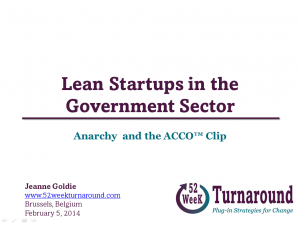The Problems you Have Left
Some greatness from Seth Godin. The truth is, the easy problems are easily solved. If you’re reading this blog it’s because you like to solve the tough ones!
Takes 1 minute to read but says a mouthful!
Creating organizational change in the real world
Some greatness from Seth Godin. The truth is, the easy problems are easily solved. If you’re reading this blog it’s because you like to solve the tough ones!
Takes 1 minute to read but says a mouthful!

Brussels, February 2014. As promised, here’s a copy of the presentation that I delivered in Brussels on February 5th. The videos cover the benefits, challenges and approaches to creating Lean Startups in Government agencies, and also how to find areas of opportunity. I also touch on some successful models of Government Lean projects in the U.S. and the links to those are below. The volume will start almost immediately, so while I’d love to believe you and all your friends are gathered around to watch this presentation…you might want to grab a set of headphones! My fantastic co-presenter Carl Danneels’ presentation on Lean Startups in the Corporate world can be found here. Lean Startups in Government Part 1: Lean Startups in the Government Sector, Part 2: Lean Startups in the Government Sector, Part 3:
http://www.washingtonpost.com/opinions/can-government-learn-how-to-fail-fast/2013/04/12/9cca9c36-9e07-11e2-a941-a19bce7af755_story.html http://fedscoop.com/radio/government-as-a-startup-with-the-lean-startup-author-eric-ries/ http://www.innovatenycschools.org/ http://www.startuplessonslearned.com/2012/05/lean-government.html http://fedscoop.com/nasa-open-government-team-broadens-focus-to-innovation/ https://www.edsurge.com/n/2013-03-26-the-lean-startup-model-goes-to-school Tennessee State projects: Scott Ritenour, sritenour ( AT) gmail.com

Thinking about making a move? Size up your Corporate Landscape or any other company you may be thinking of moving to by using our free guide, Reading the Terrain. Get your copy today by putting your email address in the subscription box at right. And no, we won’t spam you, you’ll just get our weekly update of articles.

I’m in Belgium this week, getting ready to present Anarchy and the Acco™ Clip: Lean Startups in Government at the Lean Startups Brussels meeting.
Can you imagine preparing a presentation in one language and then, on a moments notice being asked to present in another language? Yesterday I attended a workshop of Agile experts (an approach to building products and software) explaining the best uses and applications for Agile and XP which was hosted at Sirris.be. The meeting started off in Dutch, and five minutes into the meeting, an audience member requested they switch to English (no, it wasn’t me!). The panel then switched to English, offering 8 presentations in rapid fire succession (similar to the “sprint concept” in Agile) with each presenter offering an aspect of working in Agile in 5 minutes or less. It was a fascinating “deep dive” into an area I haven’t spent a lot of time in, and the experience and enthusiasm of the panel was obvious. After the presentation, the audience was divided into smaller break out groups to discuss challenges with executing and adapting Agile to the workplace, proving some issues are universal. Most of the areas involved the challenge of managing product development in a situation with diffused authority, something not uncommon in any change project. From the discussions led by the presenters it was obvious that the flexibility they had demonstrated flipping languages was also repeated in their project management. An amazing workshop, with lots of great insight and strategies.
The second event was a pitch program at Beta Group Brussels where several entrepreneurs had 5 minute to pitch their products in a way to test their marketability, similar to giving an “elevator speech” for venture capitalists. Over 300 people watched and voted on different applications, it was exciting to watch people passionately pitch their ideas. One interesting note was that sometimes the best, most marketable idea was often buried or missed in the “pitcher’s” enthusiasm for their original concept. One team, creating an online shopping site glossed over their best attribute, creating a routine, simplified, glossy marketing approach for small business owners who were NOT technically savvy, basically letting the business owners subcontract that work inexpensively to a group that would ensure that the their marketing would meet all current technical standards, and marketing for them on a consistent basis across multiple platforms (a huge issue for a frazzled small business owner). It was a great reminder that sometimes we’re so close to our creations that we miss the forest for the trees.
On a side note, much like the US there were very few females in either group, and often the females offered more “service concept” type products rather than application development or strict product development. The females had good insight into the how and why a product would or wouldn’t work, clearly we need to get more women in STEM professions!
Many thanks to my hosts from Lean Startup Brussels who are ensuring I get a great whirlwind tour of the technology community in Brussels. There’s tons of food for thought that has been shared, and I hope to be able to share it with all of you in a slightly more coherent fashion once I get some sleep!

Thinking about making a move? Size up your Corporate Landscape or any other company you may be thinking of moving to by using our free guide, Reading the Terrain. Get your copy today by putting your email address in the subscription box at right. And no, we won’t spam you, you’ll just get our weekly update of articles.

A person’s success in life can usually be measured by the number of uncomfortable conversations he or she is willing to have.” Tim Ferris
For those of you who may have seen the U.S. news in the past few days you probably heard of Georgia’s disastrous response to 2-3 inches (6.35cm) of snowfall that quickly turned to ice. Thousands of residents of the Atlanta metropolitan area attempted to leave work at the same time to go pick up children at school and outrace the ice.
The result? Trucks, cars and buses collided, blocking roads and highways rendering them impassable. Over 994 accidents were reported in the first 12 hours of the storm and many more minor ones occurred throughout the night. Commutes of 3 miles (4.82 km) stretched to 5 hours and 25 mile (40.23km) commutes became 24 hour ordeals. A baby was born on a highway, hundreds had to abandon their cars and walk for miles to get home after they ran out of gasoline.
Next was the parade of government officials trying to explain the uncoordinated response and chaos. The styles ranged from smooth to horribly awkward, and they were mercilessly skewered on twitter and social media. Some were in the awkward position of being blamed for jobs they were not responsible for but as leaders, would be held accountable for anyway. Others were openly hostile. As time went on, some leaders clearly got “off” the public relations scripting they had been prepped with while others clung to it like a lifeline, long after it stopped making any sense. Leaders of nearby counties most likely breathed a sigh of relief when they realized that the Mayor of the City of Atlanta (a small fraction of the Atlanta metro area) would be taking the majority of the heat publicly for the disaster.
One of the hardest things to do in public is to admit you are wrong. With the advances in social media and technology, it’s entirely possible that you can claim you’ve fixed something only to have live pictures scrolling alongside you on screen proving the opposite.
How do YOU handle admitting to a mistake?
The Uncomfortable Conversations series on 52weekturnaround gives you the tools to have the difficult conversations that you encounter as a change agent. See the series here.

Thinking about making a move? Size up your Corporate Landscape or any other company you may be thinking of moving to by using our free guide, Reading the Terrain. Get your copy today. And no, we won’t spam you, you’ll just get our weekly update of articles.

I was talking last week with someone I met via an article I posted on LinkedIn. I liked him immediately. Why? He took a risk, contacting a total stranger to have a conversation about connections and change. We talked for 30 minutes about how people get stuck mid-career, and why change projects can be instrumental in turning that “stuckness” around, either within the organization you work for or outside of it.
It’s easy to feel trapped mid-career. You’re good at what you do. You have a decent title. A good team, or maybe they’re only an okay team, but they don’t make you crazy. You make pretty good money. And you have kids, parents, spouses and others dependent on you staying that course and keeping that money coming in. The “golden handcuff” syndrome.
You may try to move up through the ranks, but we all know the funnel narrows towards the top. The promotions don’t come as fast as they do when you’re good, and you’re younger. And maybe when that opening at the top comes up, you don’t fit the management “flavor of the month” that year. They’re moving towards a more numeric based environment and your brand is the “people” guy. Or vice versa. Or maybe you’re not in the central core business, but you do a great job that lets everyone else get their stuff done. You’re the greatest at it, but they just don’t know what to do with you next because there’s not an obvious career path in the organization. And if they move you, your replacement may not be as easy to work with. So you clock in another year.
Problem is, your resume starts to look pretty stagnant after a while. But the kids need college tuition or your mother-in-law moves in because early Alzheimer’s disease is setting in. And the cuffs tighten. And if the company blew up tomorrow, where would you go?
You need to be an aspirin or a vitamin, not a cog in the machine.
That’s why I love projects. Projects help other see you in a new light, and expose you to new opportunities. I started working on the types of change management projects we talk about at www.52weekturnaround.com early in my career, using them as a way to meet people and learn new career skills that have allowed me to work in many wildly different fields. Lots of times I “made up” the project and assigned it to myself, just to get something started. Now people hand me projects and say, “Can you fix this?”
To create real change, for yourself or for your company, you have to stick your neck out of your comfort zone. That doesn’t mean doing something wild, or illegal. It means strategically looking at where you are and where you might like to go. What skills do you want to learn? What area is growing in your industry? What other industries use similar skills that you already possess, and what would you need to learn about their world in order to switch industries? What is the one problem in your company that is making everyone crazy? Do you have an idea how to fix it? Who can you have a conversation with that might feel a bit uncomfortable but would help you stretch? Pick a strategic action, one that will solve a real problem or create real change. Avoid busywork.
Crazy things that have happened for me when I went out of my comfort zone strategically
But here’s the thing. The wacky stuff doesn’t happen unless you’re prepared AND putting yourself out there. You have to be willing to go outside the box and share what you’re interested in. That doesn’t mean pestering every senior person you meet with “Hi, I want to change jobs, will you mentor me and by the way, know of any job openings or how I can get out of this dead end gig?” It means having something new and interesting to talk about, that makes you memorable, and allows you to engage with people outside your usual circle. What’s your elevator speech? Has it changed in the last 5 years? In each of the examples above, there’s a bit more to the story. I had been doing my homework, growing myself and working hard at it, that put me in front of the right person at the right time.
Want to start creating some change? Take a look at our resolutions for 2014. Talk to someone in another department at work that you NEVER interact with and find out what challenges they’re dealing with. Take a look at the elephant in the room and see if you’re the person that can solve it for your company. Look at how other industries, similar to yours, have solved the same type of problems your industry is dealing with. Can you have a conversation with a stranger to find out how they did it and why it worked?
Come to Brussels and hear me speak (along with my co-presenter Carl Danneels who will give a great presentation on Lean Startups in the Corporate world). And share with me some of the wacky things that have happened when you stretched out of your comfort zone, so I can share them with our readers and they can get the courage to stretch.
It’s free

If you need help seeing your current organization with fresh eyes, get a copy of our free booklet, “Reading the Terrain” by filling out your contact info here. “Reading the Terrain” is a field guide that asks you tons of questions about what’s going on in your business right now. By answering them, you’ll see where you can add value and where there are pain points.
We send out a newsletter of our most recent articles once a week and will only contact you if something really special comes up. And no, we won’t share your info with anyone.